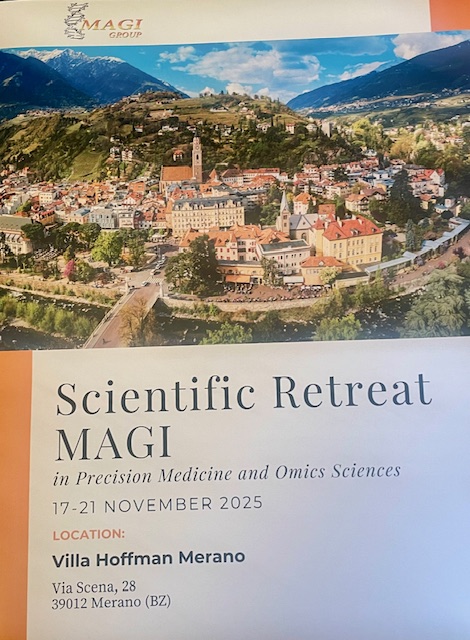At the Scientific Retreat MAGI in Precision Medicine and Omics Sciences held at Villa Hoffmann in Merano (17–21 November 2025), age-related macular degeneration (AMD) and inherited macular dystrophies were discussed together as part of a broader re-evaluation of how degenerative macular diseases are classified and investigated. Starting from a diagnostic pathway developed within MAGI and shared with retina specialists, participants examined how genetics, circulating biomarkers and, in a research setting, microbiome data might gradually be combined into an integrated, clinically usable framework.
A central point of discussion was the observation that a non-negligible proportion of patients labelled as AMD—especially those with early onset, atypical phenotypes or a strong family history—actually have inherited macular dystrophies that closely mimic AMD at fundus examination. Examples include autosomal dominant or recessive maculopathies linked to genes such as ABCA4, PRPH2, BEST1, EFEMP1, TIMP3, IMPG1, IMPG2, PROM1, ELOVL4, ABCC6, CYP4V2 and others traditionally associated with Stargardt disease, pattern dystrophy, dominant drusen, Sorsby fundus dystrophy, vitelliform dystrophies, Bietti crystalline dystrophy and related entities. These conditions were considered not as rare curiosities but as a spectrum of “AMD-like” diseases whose correct recognition has implications for prognosis, genetic counselling and potential access to targeted therapies or clinical trials.


Alongside Mendelian maculopathies, the retreat revisited the multifactorial genetics of AMD itself. The extended panel discussed includes common and rare variants in genes of the complement pathway (CFH, CFI, C3, C2, CFB, C9), the ARMS2/HTRA1 locus on 10q26, and several genes involved in lipid metabolism (APOE, CETP, LIPC, LPL, ABCA1), extracellular matrix homeostasis and angiogenesis (VEGFA, KDR). Particular attention was paid to well-known variants such as CFH Y402H and rare loss-of-function alleles in complement regulators. Rather than treating these variants as deterministic, the group emphasised that they should be interpreted as components of a broader risk architecture that needs to be evaluated together with clinical phenotype, environmental exposures and systemic inflammatory status.
To address this complexity, MAGI has designed a combined genetic and biomarker programme for patients with AMD and AMD-like maculopathies. On the genetic side, an NGS panel covers a wide set of genes for inherited macular dystrophies alongside key AMD risk loci. In parallel, a panel of plasma biomarkers—complement factors and activation fragments, inflammatory mediators, oxidative-stress indicators and detailed lipid profiles—is being evaluated as part of a multi-omics stratification strategy. In selected research contexts, analysis of the intestinal microbiome is also envisaged, reflecting growing interest in gut–retina interactions. This framework is being developed in close dialogue with ophthalmology groups from the University of Milan, the San Paolo and Sacco Hospitals (including Dr Paola Anna Salvetti and Dr Leonardo Colombo) and with colleagues from the Policlinico Gemelli in Rome, where the expertise of the medical geneticist Prof. Pietro Chiurazzi and the ophthalmologist Dr Giorgio Placidi is expected to play a key role in patient selection, phenotypic characterisation and interpretation of results.

The retreat also provided an opportunity to consider systems-biology hypotheses that move beyond a simple separation between “genetic” and “environmental” disease. One line of discussion concerned genes such as CRB1, traditionally associated with early-onset retinal dystrophies and with the maintenance of epithelial barriers. Experimental work from other groups has suggested that alterations in CRB1 and related molecules might not only affect retinal architecture but also influence intestinal barrier function, with possible consequences for microbial translocation, complement activation and systemic inflammation. Although these ideas remain speculative, they were viewed as useful conceptual tools for thinking about how genetic variants, complement dysregulation, oxidative stress and microbiome changes might converge in AMD and AMD-like conditions.
From a practical standpoint, the integrated pathway is initially being proposed for patients with atypical AMD (early onset, unusual lesion patterns, strong family history, or unexpected response to anti-VEGF therapy) and for maculopathies that cannot be clearly classified on the basis of imaging and electrophysiology alone. The workflow discussed includes careful clinical selection; collection of blood for DNA and biomarker analysis; NGS on the extended macular panel with standardised variant classification; measurement of complement and inflammatory markers; and, where appropriate, inclusion in dedicated microbiome sub-studies. The final report is conceived as a synthesis of phenotype, genotype and biomarker data, indicating whether a case appears most consistent with a Mendelian maculopathy, with multifactorial AMD, or with an intermediate profile that may justify closer monitoring or further investigation.
In terms of therapeutic implications, the Merano discussions were deliberately cautious. In the longer term, it is hoped that genetic and multi-omics data may contribute to better stratification for existing treatments—such as anti-VEGF agents for neovascular disease and emerging anti-complement therapies for geographic atrophy—as well as for future gene-based or cell-based interventions and tailored nutraceutical or lifestyle strategies. For the moment, however, participants agreed that robust evidence on the optimal use of these data in treatment decisions is still limited, and that any clinical application should be preceded by careful evaluation in prospective cohorts and, where feasible, controlled studies.
Overall, the initiative on AMD and AMD-like macular dystrophies was presented at the MAGI Scientific Retreat as a work in progress rather than a finished diagnostic product. By bringing together MAGI’s multi-omics infrastructure with the clinical expertise of ophthalmology groups in Milan and Rome, and by involving specialists such as Dr Paola Anna Salvetti, Dr Leonardo Colombo, Prof. Pietro Chiurazzi and Dr Giorgio Placidi, the project aims to clarify how much of what is now grouped under the label “AMD” actually represents a spectrum of overlapping entities. The shared view in Merano was that careful, stepwise implementation—accompanied by transparent reporting, open collaboration and realistic communication with patients—will be essential if this multi-omics approach is to contribute meaningfully to the care of people living with macular degeneration.



